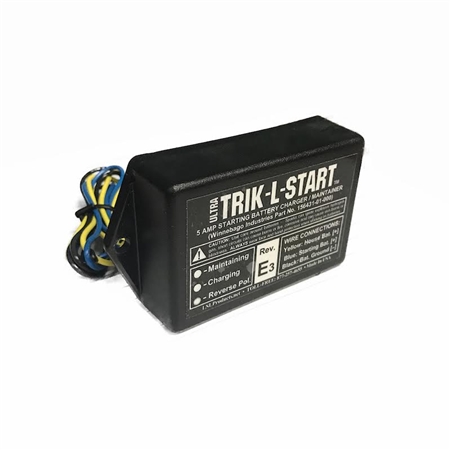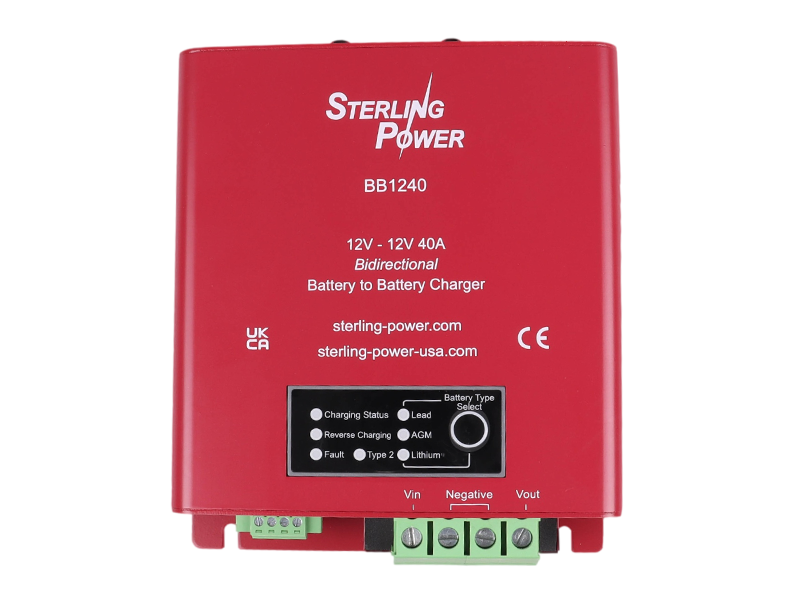Are there any dc-dc chargers that let it "reverse" charge as wel? As in when my solar gets my lifepo4 bank fully charged that it wil then charge back to my sla starter battery? I know about the renogy dc-dc-mppt unit. But the problem with that thing is the solar voltage is absolute GARBAGE and not something i can deal with. I dont have space to run 6-7 crappy 12v panels with low voltage. I have a big 560wp panel in mind for the new setup, and that would work great with for example a victron 100/50 mppt. But then i can only charge my lfp bank from it. But if that bank is full then the solar is sitting there doing nothing while it might as wel charge the starter battery. In my current config i have 2 lead acids for service and 1 for starting and a victron cyrix wich i think connects the banks together if the voltage on 1 of the 2 sides is high anough. But i obviously dont want to run a cyrix between the starter lead acid and the service lfp banks.(560Ah eve 4s2p)
You are using an out of date browser. It may not display this or other websites correctly.
You should upgrade or use an alternative browser.
You should upgrade or use an alternative browser.
dc-dc charger question
- Thread starter bobrosco
- Start date
sunshine_eggo
Happy Breffast!
You could get a wide input 8-40V to 13.8V 10A converter powered by the house battery with suitable fuses and a disconnect.
i tought about that, but then i still need to make a circuit that turns that thing on when the lfp is allmost full or completely full. Or find a way for the bms to turn that on. My plan was to use a JK bms, but i dont think they have that kind of option right?You could get a wide input 8-40V to 13.8V 10A converter powered by the house battery with suitable fuses and a disconnect.
MisterSandals
Participation Medalist
Have you considered a trickle charger for your starter battery(s)? Its not as smart as you are seeking (only run when house batteries are full) but they are quite nice for maintaining a starting battery. You should be able to enable or disable it with a manual switch or even based on house battery voltage with a little effort.But if that bank is full then the solar is sitting there doing nothing while it might as wel charge the starter battery.
I've been using one of these for about 12 years. Its been running on its own keeping my RV starter battery charged nonstop... i have not even seen it since about 2010 when i installed it under the Sprinter passenger seat pedestal!

LSL Products TLS-OEM 5 Amp Starting Battery Charger
Designed for both marine and motorhome applications, the Ultra Trik-L-Start 5 amp Starting Battery Charger/Maintainer keeps your engine starting battery fully charged, even after months of storage.
www.rvupgradestore.com
i actually found your posting about that in a different topic, but i dont see how that would work? How is it knowing my lifepo bank is full?Have you considered a trickle charger for your starter battery(s)? Its not as smart as you are seeking (only run when house batteries are full) but they are quite nice for maintaining a starting battery. You should be able to enable or disable it with a manual switch or even based on house battery voltage with a little effort.
I've been using one of these for about 12 years. Its been running on its own keeping my RV starter battery charged nonstop... i have not even seen it since about 2010 when i installed it under the Sprinter passenger seat pedestal!

LSL Products TLS-OEM 5 Amp Starting Battery Charger
Designed for both marine and motorhome applications, the Ultra Trik-L-Start 5 amp Starting Battery Charger/Maintainer keeps your engine starting battery fully charged, even after months of storage.www.rvupgradestore.com
just a normal alternator and nothing else, there are no ac chargers on my boat at all other then chargers i can hook up manually if i really need to. But that prettymuch means i have a problem and im stranded with a dead battery.What system are you going to use for engine charging, this has implications when you increase starter battery voltage?
Mike
MisterSandals
Participation Medalist
The point i tried to make was that it is NOT smart and charges all the time (well when there is sufficient source and the destination is in need of charge).i actually found your posting about that in a different topic, but i dont see how that would work? How is it knowing my lifepo bank is full?
If you wanted to control it, it would not take much to put a manual switch inline and turn it off and on that way.
If you wanted to automate it, you could put a voltage sensing controller on your house bank to determine when it charged your starting battery (smartly).
jdege
New Member
- Joined
- Dec 16, 2020
- Messages
- 138
Truthfully, I'd trust a simple circuit that I'd designed and built for something simple like that than I would whatever was going on inside some vendor's black box.If you wanted to automate it, you could put a voltage sensing controller on your house bank to determine when it charged your starting battery (smartly).
But I'd pity the guy who'd try to figure it out after I'm gone...
That is why i at first was like YES, this renogy thing is great. I mean for the price of the renogy you cant even buy a 50A victron mppt. And if someone else needs to figure out what is going on or i need to troubleshoot it in 10 years its as easy as looking in the manual. With homebuild i tend to forget what exactly i have done.Truthfully, I'd trust a simple circuit that I'd designed and built for something simple like that than I would whatever was going on inside some vendor's black box.
But I'd pity the guy who'd try to figure it out after I'm gone...
I have build an air suspension managment system in the past for a car, then 3 years down the line i wanted to modify some things, but guess what? I didnt know exactly how to do it anymore as it had been working for years without a problem.
Truthfully, I'd trust a simple circuit that I'd designed and built for something simple like that than I would whatever was going on inside some vendor's black box.
But I'd pity the guy who'd try to figure it out after I'm gone...
I've used a couple dollar trickle charger for quite a while until I built my own BMS. Now the BMS measures starter battery voltage and begins to charge it when the LiFePO4 battery has enough charge and a lower starter battery threshold is reached. Battery charging stops when a upper threshold is met.
I'm sure this trickle charger will meet your needs. All it takes is a Schottky diode (something like 5A, 40V) and an old automotive 12V, 20W light bulb. Connect the diode and bulb in series. Connect the cathode side of the diode towards the starter battery. Connect the other end of the circuit to the LiFePO4 battery. The light bulb is used as a current limit resistor. The starter battery will never go dead. The trickle charger assumes the negatives of both batteries are not isolated.
A Victron Orion DC to DC converter in each direction would work well. You would just use different setpoints on each unit. This way the lithium batteries would charge the starting battery once the lithium batteries were close to being fully charged and the alternator would charge the lithium batteries while the engine is on.
The Renogy DC to DC Mppt combo unit is garbage. Why make an MPPT controller that has a max PV input of 25V? You can't put panels in series!!
The Renogy DC to DC Mppt combo unit is garbage. Why make an MPPT controller that has a max PV input of 25V? You can't put panels in series!!
Last edited:
Its not only that you cant run any panels in series, i just flatout cant even use my panels as their voltage is allready too high as single panels...A Victron Orion DC to DC converter in each direction would work well. You would just use different setpoints on each unit. This way the lithium batteries would charge the starting battery once the lithium batteries were close to being fully charged and the alternator would charge the lithium batteries while the engine is on.
The Renogy DC to DC Mppt combo unit is garbage. Why make an MPPT controller that has a max PV input of 25V? You can't put panels in series!!
mikefitz
Solar Wizard
- Joined
- May 28, 2020
- Messages
- 2,991
Sterling Power new range of DC to DC chargers havea reverse charge function,
Mike
Yep...it's a ridiculous product. Not sure why people buy the thing.Its not only that you cant run any panels in series, i just flatout cant even use my panels as their voltage is allready too high as single panels...
im trying to find the info on it, but that page is just a 404 error...
Just go to their website and you will find them. They are very expensive https://sterling-power.com/collections/battery-to-battery-chargersim trying to find the info on it, but that page is just a 404 error...
dirt diggler
New Member
- Joined
- Apr 8, 2020
- Messages
- 105
Most if not all combined BtoB and MPPT charge controlers have a low solar input voltages .
Cteck 23V
Renogy 25V
Redarc 32V
Sterling 31V
I have a feeling they are all based on the same platform
For side by side spec reviews 12V planet is a good read, the link below is for the sterling BtoB with reverse charge

Cteck 23V
Renogy 25V
Redarc 32V
Sterling 31V
I have a feeling they are all based on the same platform
For side by side spec reviews 12V planet is a good read, the link below is for the sterling BtoB with reverse charge

Sterling Power BB1240 Battery-To-Battery Charger - 12V/12V 40A
Euro 6 DC-DC charger from Sterling Power, new design for 2022. Simple to install & setup & suits all battery types. Ideal for campervans, motorhomes & boats.
www.12voltplanet.co.uk
Which is why you would never want to use any of them.Most if not all combined BtoB and MPPT charge controlers have a low solar input voltages .
Cteck 23V
Renogy 25V
Redarc 32V
Sterling 31V
I have a feeling they are all based on the same platform
For side by side spec reviews 12V planet is a good read, the link below is for the sterling BtoB with reverse charge

Sterling Power BB1240 Battery-To-Battery Charger - 12V/12V 40A
Euro 6 DC-DC charger from Sterling Power, new design for 2022. Simple to install & setup & suits all battery types. Ideal for campervans, motorhomes & boats.www.12voltplanet.co.uk
Last edited:
dirt diggler
New Member
- Joined
- Apr 8, 2020
- Messages
- 105
I do and it works perfecrly for my application, if you (don't meen you i meen the owner of the system) choose the wrong controller for your application obv it will be an issue but all 5 i've fitted work perfectly with the already installed low voltage panels with shading issues (narrow boats on tree lined canals ect), for a stationary application or with a fresh instal with more roof space i would choose differantly, mine is into it's 3rd year of keeping my ambo/camper alive, even with 4 battery circuits to charge, horses for courses and all thatWhich is why you would never want to use any of them.
Last edited:
Similar threads
- Replies
- 20
- Views
- 1K


